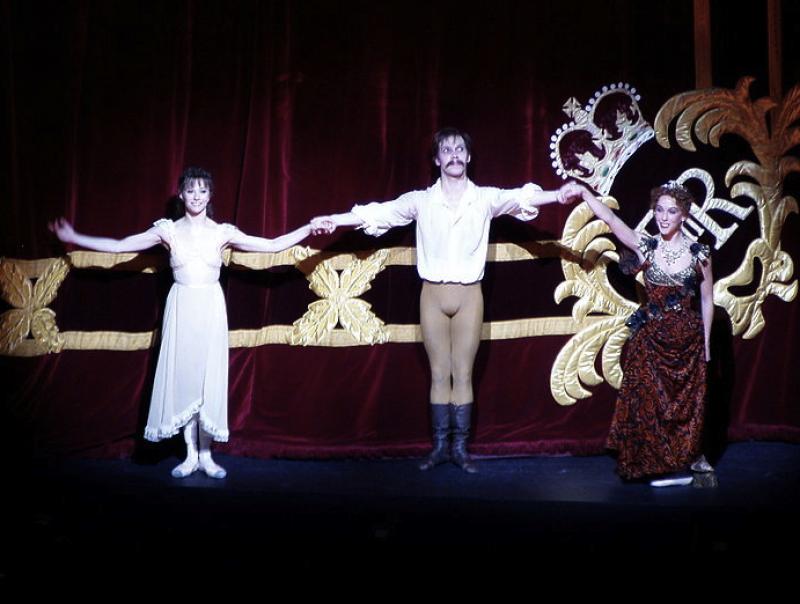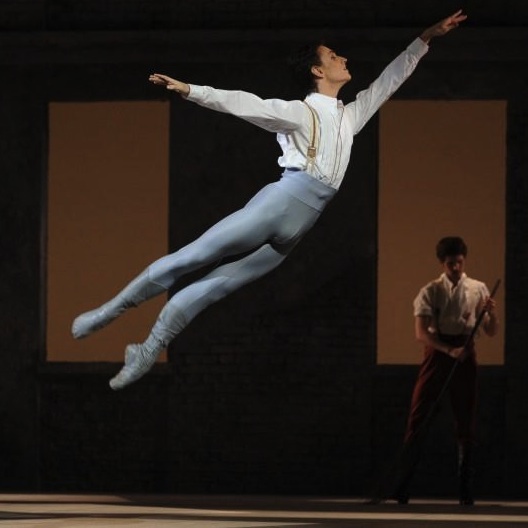Opinion: Ballet's Stars are Revolting | reviews, news & interviews
Opinion: Ballet's Stars are Revolting
Opinion: Ballet's Stars are Revolting
Alina Cojocaru joins ENB - the latest superstar to defy old company logic

Are we seeing a breakdown in the ballet company system? Where the brightest stars used to twinkle in the great companies, all is changing. Alina Cojocaru, the great Royal Ballet ballerina, has announced today she's joining English National Ballet - run by another great Royal Ballet ballerina, Tamara Rojo.
 Or since the Royal's super young male star Sergei Polunin quit Covent Garden and landed with another of Russia's "secondary" companies, the Stanislavsky Ballet (pictured right in Coppelia).
Or since the Royal's super young male star Sergei Polunin quit Covent Garden and landed with another of Russia's "secondary" companies, the Stanislavsky Ballet (pictured right in Coppelia).
Another straw in the wind was the almost unthinkable departure this month of a leading Paris Opera Ballet ballerina, Mathilde Froustey, for the much smaller San Francisco Ballet. People just don't leave Paris Opera.
Osipova, after the Mikhailovsky began to look unstable (given its owner’s business problems), agreed to join the Royal Ballet next season - but it’s hard to predict whether that’s about joining the Covent Garden company or about living in a vibrant London, where dance in general has so many fresh options.
All sorts of norms are now up on their ear. It's as if the world's top football strikers had said no to the Premier League and were forming their own.
Stars break out much younger now, often due to their own efforts rather than a slow company nurturing
Why is this happening? Two things, I'd say. One, stars break out much younger now, often due to their own efforts rather than a slow nurturing up inside a big company. Guillem, Cojocaru, Rojo, Osipova, Polunin, Vasiliev - all are self-starters, movers-on, competition-winners, all emerged as stars in their teens, all have made their own rules, defined themselves outside the expected company patterns.
They owe less to their current home companies than their own go-getting. Some of the temperament shown has been progressive, some of it obstructive - but it has demonstrated a forceful truth: that dance careers today are shorter, riskier, more vulnerable than they used to be, injuries more frequent, insecurity and ambitiousness keener.
Companies haven't responded well to this. Artistic temperament is an old, old thing, and its vagaries have been accepted for centuries in opera, where singers with stratospheric talent were accorded stratospheric tolerance levels. The Royal Ballet's record in Monica Mason's era with obvious star talents has been poor: to lose one star like Guillem would seem to be unfortunate, to lose Polunin and Cojocaru too shows real misjudgment of what the public wants to see, and what the growth of ballet needs. It is not company competence but the exceptional interpreters who inspire greater ambition in the choreographers, and hence the movement of the art.
The second thing is that companies themselves need to redefine their attractiveness to dancers of talent. That means pragmatic stuff, like money and physio, though it's not the end of it, or why would hundreds of dancers join the Bolshoi and accept a basic salary of £400 a month in the world's most expensive city? Certainly, kudos matters. But surely what drives dancers to this or that company is a search to fulfil their own artistic identity, hoping that for their brief time upon the stage they will find a home for their talent, a microclimate for their stylistic instincts and intelligent ambitions.
 Yet the aesthetic character that used to be a strong differentiator between companies has vanished. Who can really say what the Royal Ballet offers stylistically that Cojocaru does or does not fit?
Yet the aesthetic character that used to be a strong differentiator between companies has vanished. Who can really say what the Royal Ballet offers stylistically that Cojocaru does or does not fit?
Who can explain to the general public whether Boston Ballet is much different from Birmingham Royal Ballet, or whether a British dancer in a Russian company (Xander Parish at the Mariinsky) is better or worse off than a Russian dancer in a British one (Vadim Muntagirov at ENB)?
And why should unorthodox dancers like Osipova and Vasiliev put up with being constricted in old hierarchical "demi-caractère" roles in the Bolshoi when both of them are going to be wonderful in Giselle, if they're allowed to be? (Above, Ivan Vasiliev and Natalia Osipova, by Charlotte MacMillan)
The grander companies are not explaining themselves well. They are behaving like corporations and brands, not like fluctuating ecosystems of art where a single species may be crucial to the existence of several others and the general liveliness of the pond. They are not examining their own products, banning staleness in interpretation, banning repetitiousness in programming. Even if predictability is helping them flog their brand, it's putting off their finest artists.
What the second-tier companies like ENB, the Stanislavsky and Mikhailovsky are saying is that they recognise great dancers are by nature travellers, who know their own journeys - and the public wants to see them. While contracts must be signed to ensure the public and company discipline aren't let down, these artists don't rate corporate identity as "them", especially if they aren't over-impressed by their artistic director's judgement.
If a choreographer is central to a company, there you will find stable, loyal artists
The prime reason for this change is the lack of choreographers. All the greatest artists want to be in new work. The eco-chain is that a fine director attracts a fine choreographer who is drawn to the best dancers. If a choreographer is central to a company, there you will find stable, embedded artists on whom the choreographer will create a "style" that will spread to others and to the training of the next generation to dance those works. At the Royal the dancing "style" was generated largely but not exclusively out of Frederick Ashton, and the acting "style" out of Kenneth MacMillan. Cojocaru was triumphant in both, as it happens, despite her Russian training.
But if a company lacks a solid link with a sought-after choreographer, it can't expect its finest artists to be satisfied with the repeat part of repertoire. They will seek change, because it's in the nature of performing artists never to be quite satisfied, never to be quite happy, never to be the same as others. And if they can't change the rep, they'll change their surroundings.
Ballet is not an equal opportunities utopia, and its very health depends on that. At the Royal Ballet the special treatment of Fonteyn and Nureyev was divisive, but no one can argue it did not embellish the company's world reputation, and drive up new generations of excited young dancers in their footsteps who themselves fed choreographers.
ENB has endemic box-office problems, and Rojo looks as if she’s tackling the issue by trialling the original "stars" set-up of ENB's precursor, Festival Ballet. It was fascinating to see how quickly she dealt with the casting question when she arrived as player-manager at the start of this current season: Vadim Muntagirov is the young man everyone wants to see at ENB, and it was expected that Rojo would pair herself with him to maximise the box office. But after the opening run of The Sleeping Beauty (which his favourite partner, the popular Daria Klimentová, does not like dancing), Rojo restored the Klimentová-Muntagirov star pairing and relied on her own fame to build up some of ENB's less well-known men. That meant two good box-office cast options.
While it's startling to see Rojo and Cojocaru, the Royal's two sublime rivals, bonding like sisters at ENB, Rojo is a mistress of Realpolitik, and she knows she will have yet another box-office star for Le Corsaire, her big new production in the autumn, as well as help to draw the public for new creations next spring. And she's giving Cojocaru the freedom she wants to dance with her two other favoured companies, American Ballet Theatre in New York and Hamburg Ballet. This way both company and star are happy.
Here’s a side-thought - Osipova's recruitment to the Royal Ballet will bring her hugely engaging and brilliantly talented fiancé, Ivan Vasiliev, to London. He, like Cojocaru, is running a multi-company international career. He has already guested with ENB. Will he join the troupe to dance with Cojocaru? The male-fest Le Corsaire is tailor-made for him.
Down the road in WC2, the Royal Ballet is reeling
Meanwhile, down the road in WC2, the Royal Ballet is reeling. In September it opens Carlos Acosta’s much-anticipated new Don Quixote production, a scorching test of ballerinas. It was a body blow to Acosta when Cojocaru suddenly quit the Royal this summer, as she was one of the very few ballerinas capable of delivering the leading role - along with Rojo, of course, who was still on the Covent Garden roster when the company and Acosta committed themselves to the new production.
Rojo, who had a long, close partnership with Acosta at the Royal, is now in the position of fielding the stars he wishes he could have in her own premiere at ENB.
Suddenly, in these times, it’s stars who have the bargaining power, and the companies who must play ball. And the public, for sure, will love it.
- English National Ballet dances a Rudolf Nureyev triple bill at the London Coliseum 25-27 July; the Le Corsaire UK tour opens in Milton Keynes on 17 October, with Cojocaru scheduled
- The Royal Ballet's new Don Quixote produced by Carlos Acosta opens at the Royal Opera House 30 September
Explore topics
Share this article
Add comment
The future of Arts Journalism
You can stop theartsdesk.com closing!
We urgently need financing to survive. Our fundraising drive has thus far raised £49,000 but we need to reach £100,000 or we will be forced to close. Please contribute here: https://gofund.me/c3f6033d
And if you can forward this information to anyone who might assist, we’d be grateful.

Subscribe to theartsdesk.com
Thank you for continuing to read our work on theartsdesk.com. For unlimited access to every article in its entirety, including our archive of more than 15,000 pieces, we're asking for £5 per month or £40 per year. We feel it's a very good deal, and hope you do too.
To take a subscription now simply click here.
And if you're looking for that extra gift for a friend or family member, why not treat them to a theartsdesk.com gift subscription?
more Dance
 'We are bowled over!' Thank you for your messages of love and support
Much-appreciated words of commendation from readers and the cultural community
'We are bowled over!' Thank you for your messages of love and support
Much-appreciated words of commendation from readers and the cultural community
 R:Evolution, English National Ballet, Sadler's Wells review - a vibrant survey of ballet in four acts
ENB set the bar high with this mixed bill, but they meet its challenges thrillingly
R:Evolution, English National Ballet, Sadler's Wells review - a vibrant survey of ballet in four acts
ENB set the bar high with this mixed bill, but they meet its challenges thrillingly
 Like Water for Chocolate, Royal Ballet review - splendid dancing and sets, but there's too much plot
Christopher Wheeldon's version looks great but is too muddling to connect with fully
Like Water for Chocolate, Royal Ballet review - splendid dancing and sets, but there's too much plot
Christopher Wheeldon's version looks great but is too muddling to connect with fully
 iD-Reloaded, Cirque Éloize, Marlowe Theatre, Canterbury review - attitude, energy and invention
A riotous blend of urban dance music, hip hop and contemporary circus
iD-Reloaded, Cirque Éloize, Marlowe Theatre, Canterbury review - attitude, energy and invention
A riotous blend of urban dance music, hip hop and contemporary circus
 How to be a Dancer in 72,000 Easy Lessons, Teaċ Daṁsa review - a riveting account of a life in dance
Michael Keegan-Dolan's unique hybrid of physical theatre and comic monologue
How to be a Dancer in 72,000 Easy Lessons, Teaċ Daṁsa review - a riveting account of a life in dance
Michael Keegan-Dolan's unique hybrid of physical theatre and comic monologue
 A Single Man, Linbury Theatre review - an anatomy of melancholy, with breaks in the clouds
Ed Watson and Jonathan Goddard are extraordinary in Jonathan Watkins' dance theatre adaptation of Isherwood's novel
A Single Man, Linbury Theatre review - an anatomy of melancholy, with breaks in the clouds
Ed Watson and Jonathan Goddard are extraordinary in Jonathan Watkins' dance theatre adaptation of Isherwood's novel
 Peaky Blinders: The Redemption of Thomas Shelby, Rambert, Sadler's Wells review - exciting dancing, if you can see it
Six TV series reduced to 100 minutes' dance time doesn't quite compute
Peaky Blinders: The Redemption of Thomas Shelby, Rambert, Sadler's Wells review - exciting dancing, if you can see it
Six TV series reduced to 100 minutes' dance time doesn't quite compute
 Giselle, National Ballet of Japan review - return of a classic, refreshed and impeccably danced
First visit by Miyako Yoshida's company leaves you wanting more
Giselle, National Ballet of Japan review - return of a classic, refreshed and impeccably danced
First visit by Miyako Yoshida's company leaves you wanting more
 Quadrophenia, Sadler's Wells review - missed opportunity to give new stage life to a Who classic
The brilliant cast need a tighter score and a stronger narrative
Quadrophenia, Sadler's Wells review - missed opportunity to give new stage life to a Who classic
The brilliant cast need a tighter score and a stronger narrative
 The Midnight Bell, Sadler's Wells review - a first reprise for one of Matthew Bourne's most compelling shows to date
The after-hours lives of the sad and lonely are drawn with compassion, originality and skill
The Midnight Bell, Sadler's Wells review - a first reprise for one of Matthew Bourne's most compelling shows to date
The after-hours lives of the sad and lonely are drawn with compassion, originality and skill
 Ballet to Broadway: Wheeldon Works, Royal Ballet review - the impressive range and reach of Christopher Wheeldon's craft
The title says it: as dancemaker, as creative magnet, the man clearly works his socks off
Ballet to Broadway: Wheeldon Works, Royal Ballet review - the impressive range and reach of Christopher Wheeldon's craft
The title says it: as dancemaker, as creative magnet, the man clearly works his socks off
 The Forsythe Programme, English National Ballet review - brains, beauty and bravura
Once again the veteran choreographer and maverick William Forsythe raises ENB's game
The Forsythe Programme, English National Ballet review - brains, beauty and bravura
Once again the veteran choreographer and maverick William Forsythe raises ENB's game

Comments
I don't think that they're
As a member of the ballet
The RoH needs to rethink its
for the much smaller San
Here's an interesting
In this country,outside of